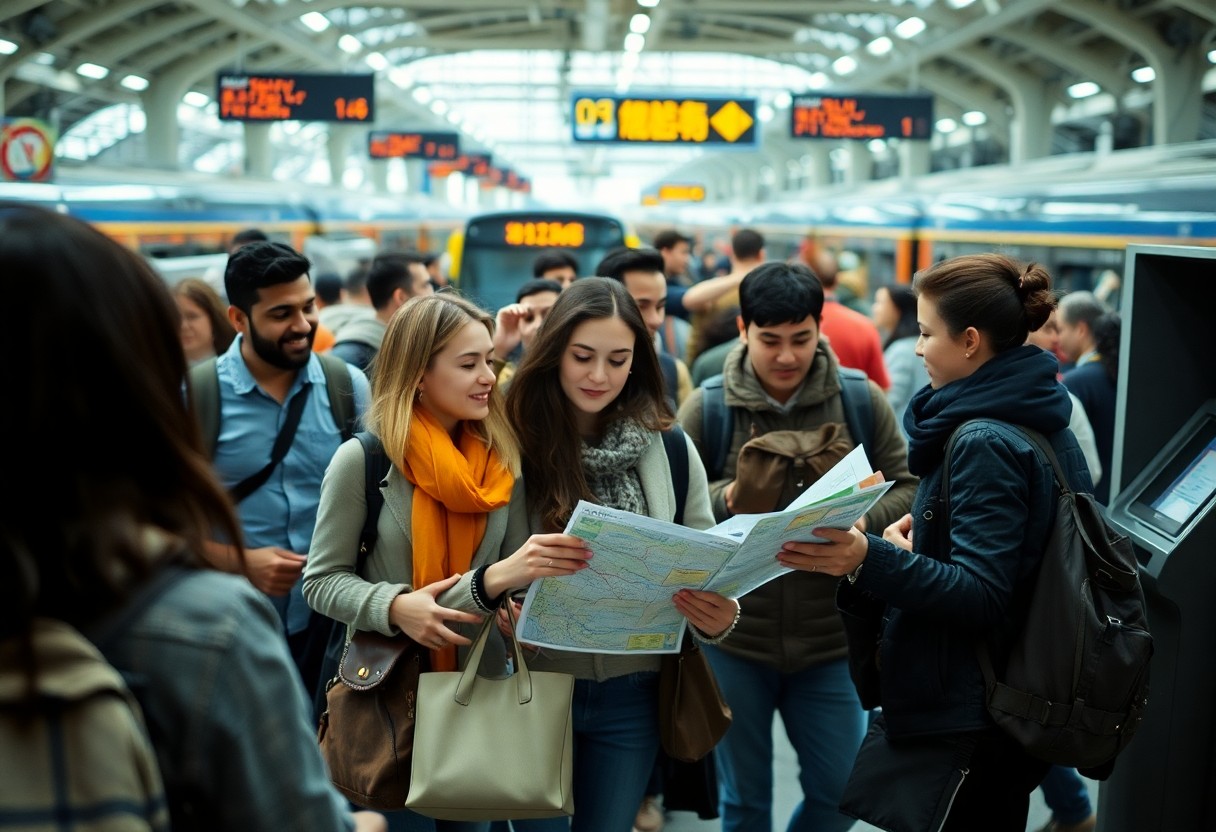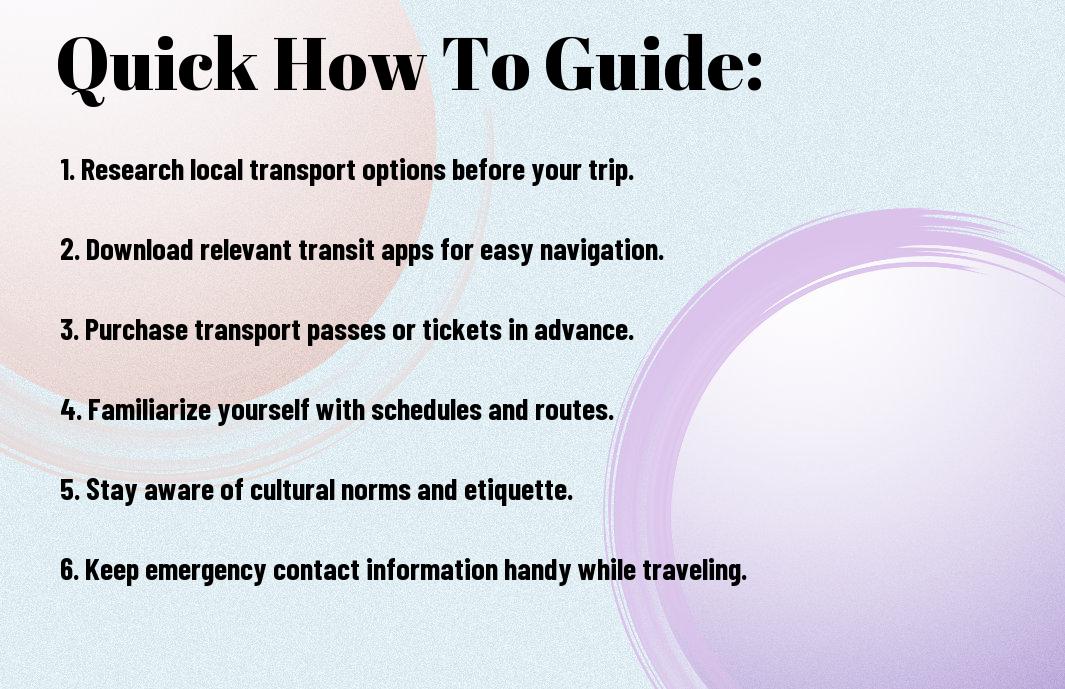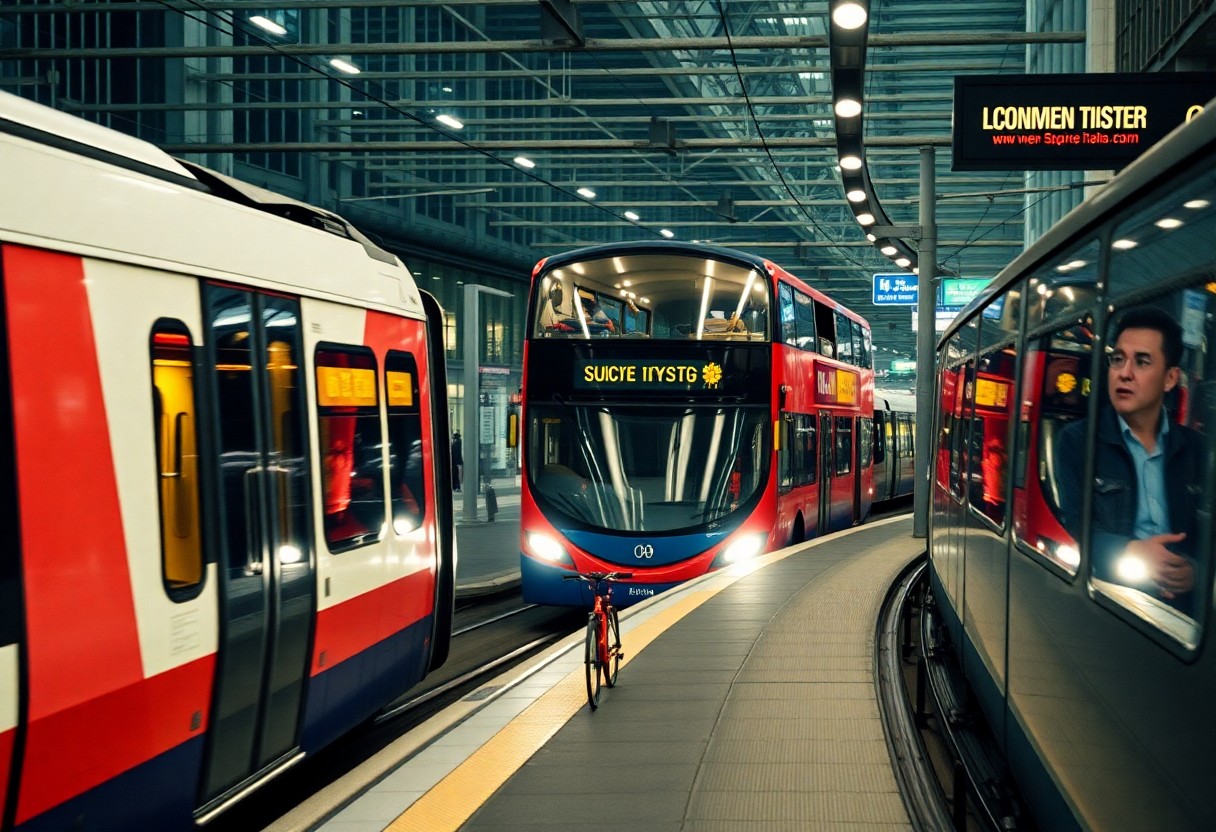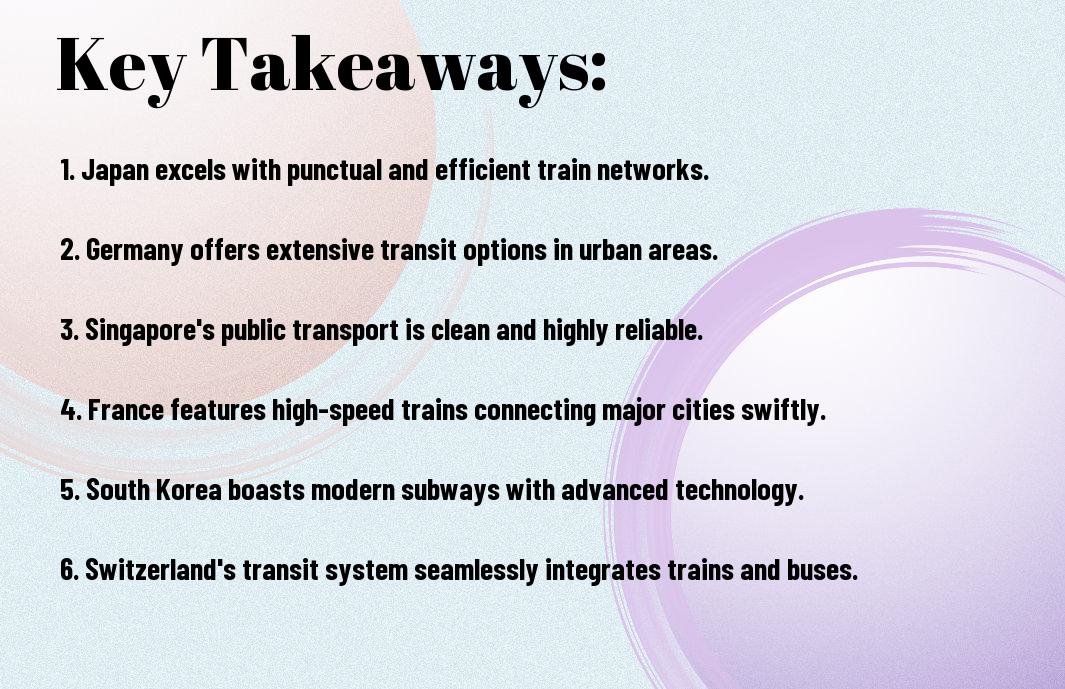Transportation can be both exciting and daunting when traveling abroad. To navigate unfamiliar cities with ease, it’s imperative to understand how to effectively use public transportation systems. In this guide, you will discover expert tips and tricks to make your journey smoother, from understanding schedules and ticketing to mastering local customs. By equipping yourself with the right knowledge, you can confidently explore your destination while saving time and money. Let’s examine the imperative steps that will help you travel like a pro!

Key Takeaways:
- Research local transit options: Before traveling, familiarize yourself with the public transportation systems available at your destination, such as buses, subways, or trams.
- Purchase passes in advance: Look into day passes or travel cards that can save you money and time, especially if you plan to use public transit frequently.
- Download apps for navigation: Utilize transportation apps to help with route planning, real-time updates, and finding the best options to reach your destination.
- Learn key phrases in the local language: Basic communication skills can enhance your experience, especially for asking for directions or understanding transit signage.
- Stay aware of your surroundings: Keep an eye on your belongings and be mindful of your surroundings to ensure a safe and pleasant journey.

Understanding Public Transportation Systems
To navigate a new city with ease, it’s important to grasp the public transportation system in place. Knowing how to identify various transport options, their schedules, and routes will simplify your journeys, allowing you to explore like a local and save time and money.
Types of Public Transportation
To fully utilize public transportation, familiarizing yourself with the different types available is beneficial:
- Buses
- Subways
- Trains
- Trams
- Taxis and Rideshares
After selecting your preferred mode of transport, you can confidently initiate on your travel adventures.
| Type | Description |
|---|---|
| Buses | Commonly used for both short and long distances |
| Subways | Fast and efficient for urban travel |
| Trains | Connects cities and rural areas over longer distances |
| Trams | Ideal for local travel within cities |
| Taxis and Rideshares | Convenient for direct, flexible transport |
How Public Transportation Works Abroad
Now that you have an overview of the types of transportation, understanding how they operate is key to your success. Each city may have unique systems, payment methods, and schedules that are important to grasp before your travels.
Understanding how public transportation operates abroad helps minimize confusion. It’s advisable to research the local transit rules, fare structures, and any available apps or websites that provide real-time updates on transit schedules. Mastering these elements ensures you can efficiently move around your destination without encountering unexpected challenges.
How to Plan Your Public Transportation Route
You can navigate foreign cities like a pro by effectively planning your public transportation route. Start by familiarizing yourself with the various transit options available, as they can differ significantly from what you are used to. Be sure to check schedules, map routes, and understand ticketing systems to make your travel experience as smooth as possible.
Researching Local Transit Options
Local transit systems often include buses, trams, trains, and subways, each with its own rules and schedules. Look for official transportation websites or local guides that outline the services offered, including any discounts for tourists or special day passes. Understanding these options can help you choose the best routes to your destination.
Using Navigation Apps and Websites
Websites and apps can serve as invaluable tools when navigating public transportation abroad. They offer real-time updates on schedules, route information, and even alerts for delays or changes. By inputting your starting point and destination, these resources can provide optimized travel suggestions based on current conditions.
Another advantage of using navigation apps and websites is the ability to save your routes for offline access. Many apps allow you to download maps and schedules, so you won’t need an internet connection while traveling. This feature is especially helpful in areas with limited service. Utilizing these digital tools can significantly enhance your confidence and efficiency as you explore new cities using public transportation.
Tips for Purchasing Tickets
Keep your ticket purchasing experience smooth by following these imperative tips:
- Research ticket options ahead of time.
- Buy tickets at kiosks or vending machines when possible.
- Use mobile apps for convenience and potentially discounted fares.
- Always check for return or multi-ride tickets to save money.
Assume that situations may arise where you will need to ask for assistance; language barriers can often be navigated with simple phrases or translation apps.
Understanding Fare Structures
Little do many travelers know that fare structures vary significantly between cities. Some transportation systems may charge based on zones, while others have flat rates regardless of distance. Familiarize yourself with the local fare system to ensure you are purchasing the correct ticket and avoiding unnecessary penalties.
Buying Tickets: Methods and Best Practices
Practices for buying tickets can greatly enhance your public transportation experience abroad. Start by identifying the most common ticket purchasing methods available in your destination, as this can save you valuable time and avoid confusion.
Another effective strategy is to familiarize yourself with the available methods for purchasing tickets. Many major cities offer an array of options, including contactless payment systems, cash transactions at kiosks, and mobile apps. Ensure you have a suitable payment method ready, and consider carrying a small amount of local currency for instances where electronic payments may not be accepted. This way, you can enjoy a hassle-free transit experience without the stress of ticketing issues.
Factors to Consider When Using Public Transportation
All travelers should keep several factors in mind when utilizing public transportation abroad. These considerations will enhance your experience and ensure smoother journeys:
- Research local transportation options and routes.
- Familiarize yourself with ticket purchasing procedures.
- Check for operating hours and frequency of services.
- Stay informed about peak travel times.
- Consider language barriers and identification methods.
After weighing these factors, you’ll be better prepared to navigate the public transport system efficiently.
Safety and Security Measures
Some necessary safety and security measures can help you avoid potential issues while using public transportation. Always keep your belongings close, and be aware of your surroundings. Utilize well-lit stations or stops, especially at night, and avoid displaying valuable items. If you feel uncomfortable, don’t hesitate to seek assistance from staff or fellow passengers.
Cultural Etiquette on Public Transport
Public transportation varies greatly across cultures, and understanding local etiquette can make your journey more pleasant. Observing local norms, such as giving up your seat to those in need or keeping noise to a minimum, can enhance your experience.
To fully immerse yourself in the local culture, take time to observe how other passengers behave. In some places, maintaining personal space is necessary, while in others, close proximity is the norm. Speaking quietly and avoiding phone calls can also be important, as loud conversations may be deemed disrespectful. By adapting to local customs, you not only show respect but may also foster a more enjoyable atmosphere during your travels.
Navigating Challenges on Public Transportation
Once again, using public transportation abroad can present unique challenges. From crowded buses to complex train systems, you may encounter obstacles that could deter even the most seasoned traveler. However, with the right mindset and preparation, you can navigate these situations skillfully, ensuring your journey remains smooth and enjoyable. Embrace the unexpected and stay adaptable; you’ll often discover hidden gems and local insights along the way.
Overcoming Language Barriers
Assuming you are in a country where the language is different from your own, language barriers may feel intimidating. To tackle this, consider downloading translation apps or carrying a pocket phrasebook. Familiarize yourself with common transportation terms and phrases to facilitate interactions with locals. Using visual aids, like maps and signs, can also enhance your understanding of transit systems, making communication more accessible.
Dealing with Delays and Cancellations
Some delays and cancellations are unavoidable when relying on public transportation. Instead of allowing frustration to set in, focus on staying calm and finding solutions. Maintaining a flexible schedule can help, as it gives you room to adjust your plans in response to any setbacks.
This approach not only helps alleviate stress but also allows you to make the most of unexpected downtime. Use delays to explore nearby attractions or grab a snack. Keep your smartphone handy to check for real-time updates on schedules, and have backup plans ready while you navigate through the challenges of public transportation abroad.
Enhancing Your Experience on Public Transportation
Despite the challenges that come with unfamiliar public transportation systems, you can enhance your experience by being adaptable and open-minded. Embrace local customs, engage with fellow travelers and locals, and take the time to plan your routes in advance. Utilizing mobile apps and translation tools can also help you navigate the system more effectively, making your commute not just efficient but enjoyable.
Making the Most of Your Journey
The journey can be a wonderful cultural experience if you approach it positively. Use the time spent in transit to relax, read a book, listen to music, or practice the local language. This way, you turn travel time into an opportunity for personal enrichment or reflection, enhancing your overall travel experience.
Exploring the City through Public Transit
Through public transit, you can connect deeply with the city’s culture and daily life. Each bus, train, or tram you board is an invitation to witness the locals’ way of living and operating, turning your commute into a mini-adventure.
Transit systems often cover vast areas, allowing you to traverse various neighborhoods that you might miss when using taxis or rideshares. By choosing public transit, you’re not just getting from point A to point B; you’re immersing yourself in the rhythms of the city. You’ll discover hidden gems, from quaint cafes to lively markets, and meet new people who may share their recommendations and stories with you. This authentic connection can greatly enrich your travel experience and make your time abroad truly memorable.
To wrap up
On the whole, using public transportation abroad can enhance your travel experience and save you money. By familiarizing yourself with local transit systems, obtaining maps and apps, and understanding cultural nuances, you’ll navigate easily and confidently. Always keep your belongings secure and be mindful of peak hours to avoid crowds. Engaging with locals and asking for assistance can also enrich your journey. Embrace the adventure of discovering a new place through its public transit, and you’ll likely uncover hidden gems along the way.
Q: What are the best ways to plan my public transportation routes abroad?
A: To effectively plan your public transportation routes, start by downloading relevant transportation apps specific to the city or country you are visiting. Many cities have their own transit apps that offer real-time updates, maps, and route planning. Additionally, familiarize yourself with the local transit system by checking their website for maps and schedules. You can also use global apps like Google Maps, which can provide public transport options and estimated travel times. Always consider peak hours and any service disruptions, and give yourself extra time to navigate unfamiliar routes.
Q: How can I communicate and ask for help if I get lost?
A: If you find yourself lost while using public transportation, don’t hesitate to ask locals for assistance. It can be helpful to learn a few key phrases in the local language, such as “Where is…?” or “How do I get to…?” You can also use translation apps to help bridge any language barriers. Additionally, carrying a map or a screenshot of your desired route in the local language can make it easier to show to someone for directions. Look for transit staff at stations; they are typically trained to assist travelers. A friendly smile and patience go a long way in getting help.
Q: What are the etiquette tips I should follow when using public transportation abroad?
A: Etiquette can vary greatly depending on the country, but some general tips apply: always give up your seat for the elderly, pregnant women, or those who seem in need; keep your volume low when talking or listening to music; and be mindful of personal space, especially during peak hours. Avoid blocking entrances or exits, and remember to take your bags off the seat next to you during busy times. If eating is allowed, choose non-messy snacks to avoid causing a disturbance. Finally, observing and following the local customs will help you integrate more seamlessly into the culture while traveling.



